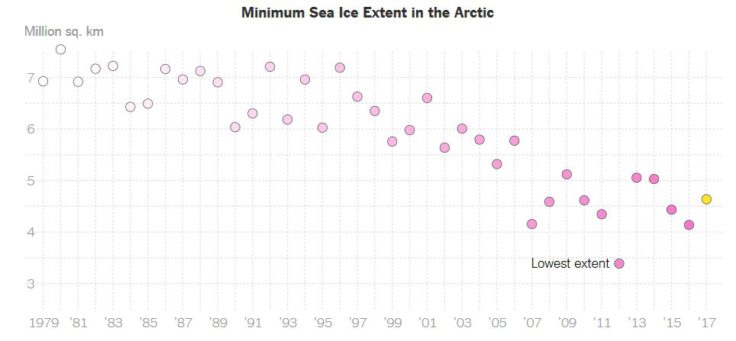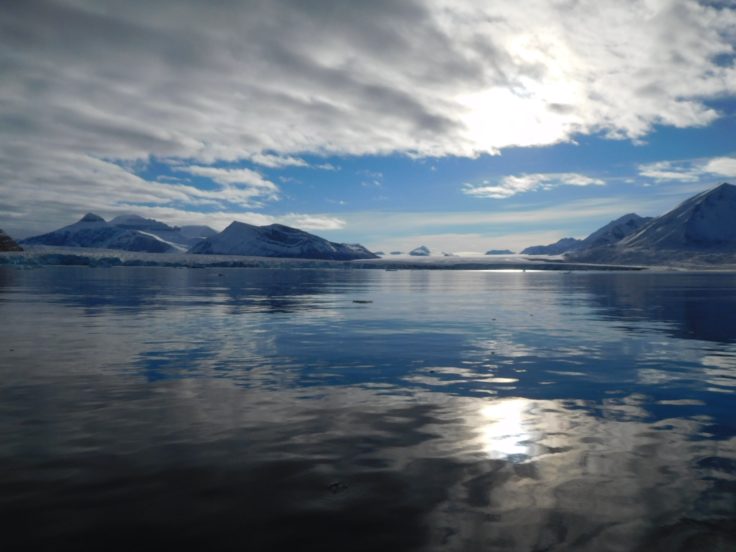Arctic sea ice at minimum extent for 2017
Arctic sea ice extent has likely reached its minimum extent for the year, at 4.64 million square kilometers (1.79 million square miles) on September 13, 2017, according to a team of international scientists. The 2017 minimum is the eighth lowest in the 38-year satellite record. The Arctic sea ice minimum marks the day – typically in mid-September – when sea ice reaches its smallest extent at the end of the summer melt season.
The retreat of summer Arctic sea ice is unquestionable. For over 35 years special satellite-mounted sensors, which can see through cloud and the polar night, have obtained daily ‘images’ of the entire Arctic region. From these images, the extent of the sea ice has been accurately determined, year after year. This data shows September sea ice has declined from over 7 million km2 in the 1970s to about 3.5 million km2 in 2012; a loss of about half the summer Arctic sea ice cover.

The reduction in Arctic sea ice is not expected to be constant from one year to the next. For example, a year with smaller ice extent could be followed by a number of years with a significantly larger ice extent. This is natural variability in action, and fully expected. However, the ice extent in the last five has been above than the 2012 minimum, but well below the long-term average but above the minimum; this is neither unusual nor unexpected. More significant is the trend (the change over the entire time-series); which unquestionably shows a substantial decrease (see graph above). Importantly, most climate models predict that the extent of the summer Arctic sea ice will continue to retreat over the coming decades; none show an increase.
Arctic change
Changes witnessed in the Arctic system are happening that only a decade ago would not have been thought possible. These changes have the potential, through complex linkages and feedback mechanisms, to influence all aspects of the Earth system. As a consequence, Arctic change will have a significant impact on the livelihoods of Arctic residents, as well as considerable socio-economic implications at national, regional, and global levels.
Robust science for robust policy making
Given the global consequences of Arctic change scientists have to ensure that the public, industry, national and international politicians and policy-makers have the most up-to-date and robust science available on Arctic change. Good policy decisions are based on rigorous scientific analysis. The recent suggestion that Arctic summer sea ice is increasing since the 2012 minimum needs to be placed in context within the time-series available.

Dr Jeremy Wilkinson from British Antarctic Survey is working on an EU-funded science programme ICE-ARC to look at the economic cost of Arctic change. He says:
“In 2017 we can see a new minimum in Arctic sea ice extent in winter and the eight lowest in summer extent. The long-term downward trend in sea ice extent continues. Every year we deploy robotic instrumentation on the Arctic sea ice in order to monitor its evolution. This year we found it particularly difficult to find robust ice to deploy our instrumentation on. Arctic ice is becoming thinner and less resilient to a warmer climate.”
UK in the Arctic
The Arctic is an ocean surrounded by land and Arctic sea ice is the thin layer of frozen ocean water that forms and grows during the winter, and melts in the summer.
The Natural Environment Research Council’s Arctic Office, is hosted by the British Antarctic Survey. It supports UK research in the Arctic; provides advice to policy makers; and develops international scientific collaboration. The Office also manages the UK’s research station in the Arctic in Ny-Ålesund, Svalbard. Further information is here
See the 2017 Arctic summer sea-ice data on the National Snow and Ice Data Centre (NSIDC) website here